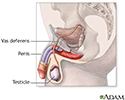Curvature of the penis
Peyronie's disease
Curvature of the penis is an abnormal bend in the penis that occurs during erection. It is also called Peyronie's disease.
Causes
In Peyronie's disease, fibrous scar tissue develops in the deep tissues of the penis. The cause of this fibrous tissue is often not known. It can occur spontaneously.
Fracture of the penis (injury during intercourse) can lead to this condition. Men are at higher risk of developing curvature of the penis after surgery or radiation treatment for prostate cancer.
Peyronie's disease is uncommon. It affects men ages 40 to 60 and older.
Curvature of the penis can occur along with Dupuytren's contracture . This is a cord-like thickening across the palm of one or both hands. It is a fairly common disorder in white men over age 50. However, only a very small number of people with Dupuytren's contracture develop curvature of the penis.
Dupuytren's contracture
Dupuytrens contracture is a painless thickening and tightening (contracture) of tissue beneath the skin on the palm of the hand and fingers.
Other risk factors have not been found. However, people with this condition have a certain type of immune cell marker, which indicates that it may be inherited.
Newborns may have a curvature of the penis. This may be part of an abnormality called hypospadias , which is different from Peyronie's disease.
Hypospadias
Hypospadias is a birth (congenital) defect in which the opening of the urethra is on the underside of the penis. The urethra is the tube that drains...
Symptoms
You or your health care provider may notice an abnormal hardening of the tissue below the skin, in one area along the shaft of the penis.
During erection, there may be:
- A bend in the penis, which most often begins at the area where you feel the scar tissue or hardening
- Softening of the portion of the penis beyond the area of scar tissue
- Narrowing of the penis
- Pain
- Problems with penetration or pain during intercourse
- Shortening of the penis
Exams and Tests
The health care provider can diagnose curvature of the penis with a physical exam. The hard plaques can be felt with or without an erection.
The health care provider may give you a shot of medicine to cause an erection. Or, you may provide your health care provider with pictures of the erect penis for evaluation.
An ultrasound may show the scar tissue in the penis. However, this test is not necessary.
Ultrasound
Ultrasound uses high-frequency sound waves to make images of organs and structures inside the body.

Treatment
At first, you may not need treatment. Some or all of the symptoms may improve over time or may not get worse.
Treatments may include:
- Corticosteroid injections into the fibrous band of tissue
- Potaba (a medicine taken by mouth)
-
Radiation therapy
Radiation therapy
Radiation therapy uses high-powered x-rays, particles, or radioactive seeds to kill cancer cells.
 ImageRead Article Now Book Mark Article
ImageRead Article Now Book Mark Article -
Shock wave
lithotripsy
Lithotripsy
Lithotripsy is a procedure that uses shock waves to break up stones in the kidney, bladder, or ureter (tube that carries urine from your kidneys to y...
 ImageRead Article Now Book Mark Article
ImageRead Article Now Book Mark Article - Verapamil injection (a medicine used to treat high blood pressure)
- Vitamin E
However, these treatments often do not help much, or at all. They also may cause more scarring.
If medicine and lithotripsy do not help, and you are unable to have intercourse because of the curve of the penis, surgery may be done to correct the problem. However, some types of surgery may cause impotence . It should only be done if intercourse is impossible.
Impotence
An erection problem occurs when a man cannot get or keep an erection that is firm enough for intercourse. You may not be able to get an erection at ...

A penile prosthesis may be the best treatment choice for curvature of the penis with impotence.
Outlook (Prognosis)
The condition can get worse and make it impossible for you to have intercourse. Impotence can also occur.
When to Contact a Medical Professional
Call your health care provider if:
- You have symptoms of curvature of the penis.
- Erections are painful.
- You have a sharp pain in the penis during intercourse, followed by swelling and bruising of the penis.
References
Elder JS. Anomalies of the penis and urethra. In: Kliegman RM, Behrman RE, Jenson HB, Stanton BF, eds. Nelson Textbook of Pediatrics . 19th ed. Philadelphia, PA: Elsevier Saunders; 2011:chap 538.
Jordan GH, McCammon KA. Peyronie's disease. In: Wein AJ, ed. Campbell-Walsh Urology . 10th ed. Philadelphia, PA: Elsevier Saunders; 2011:chap28.
Jordan GH. McCammon KA. Surgery of the penis and urethra. In: Wein AJ, ed. Campbell-Walsh Urology . 10th ed. Philadelphia, PA: Elsevier Saunders; 2011:chap 36.
-
Male reproductive anatomy - illustration
The male reproductive structures include the penis, the scrotum, the seminal vesicles and the prostate.
Male reproductive anatomy
illustration
-
Male reproductive system - illustration
The male reproductive system, viewed from a sagittal section.
Male reproductive system
illustration
-
Male reproductive anatomy - illustration
The male reproductive structures include the penis, the scrotum, the seminal vesicles and the prostate.
Male reproductive anatomy
illustration
-
Male reproductive system - illustration
The male reproductive system, viewed from a sagittal section.
Male reproductive system
illustration
Review Date: 1/21/2015
Reviewed By: Scott Miller, MD, urologist in private practice in Atlanta, GA. Also reviewed by David Zieve, MD, MHA, Isla Ogilvie, PhD, and the A.D.A.M. Editorial team.


